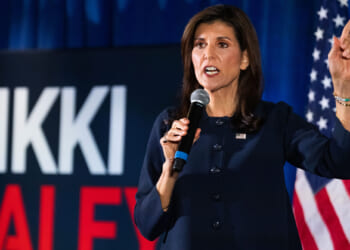
President Trump on Monday sent letters to seven countries, including Japan and South Korea, announcing heavy tariffs on goods they send to the U.S., making critical Asian allies the first targets of his summer round of levies.
Mr. Trump smacked Japan and South Korea with 25% tariff apiece and announced levies ranging from 25% to 40% on Kazakhstan, Laos, Malaysia, Myanmar and South Africa.
Mr. Trump’s letters, which he posted to his social media website, are cordial in tone but say the U.S. has been harmed by a trade situation he views as unfair.
“We have decided to move forward with you, but only with more balanced, and fair, TRADE,” Mr. Trump wrote in separate letters to Japanese Prime Minister Ishiba Shigeru, South Korean President Lee Jae-myung and presidents, prime ministers and sultans of other countries.
Trading partners are bracing for Mr. Trump’s nation-by-nation decisions on “Liberation Day” tariffs that were announced in April, then paused for 90 days. The reimposed tariffs will take effect on Aug. 1, a notable shift from the general expectation that levies would return on Wednesday.
White House press secretary Karoline Leavitt said about a dozen countries would be assigned tariffs in similar letters Monday, and the implementation delay allowed space for further negotiation.
SEE ALSO: Trump says he is poised to assign tariffs, announce new trade deals
“The president and his trade team want to cut the best trade deals for the American people and the American worker,” Ms. Leavitt said.
She rejected the idea that Mr. Trump will lose credibility with other countries if he continues to delay his tariffs.
“They will take the president seriously,” Ms. Leavitt said.
Some analysts said the delays will unnerve Wall Street investors, who want certainty, and the Federal Reserve, which wants to know the tariff levels before cutting interest rates. Countries might try to wait out Mr. Trump’s term instead of negotiating over a moving target.
“Other countries are seeing what President Trump’s word is worth. If he won’t honor his own agreements, he probably isn’t worth negotiating with,” said Ryan Young, a senior economist at the Competitive Enterprise Institute, a free-enterprise think tank. “It might be better to play the waiting game and see if courts or Congress give his tariff-making powers back to Congress.”
The newly announced tariffs are on par with the levies Mr. Trump proposed for Japan and South Korea during his initial announcement, so the White House is reverting to form after negotiations failed to produce deals.
SEE ALSO: Treasury Secretary Scott Bessent: ‘Tariff derangement syndrome’ is driving criticism of trade plan
Laos and Myanmar will face a 40% tariff — down from 48% and 44%, respectively, in April.
Products from Kazakhstan and Malaysia will face a 25% levy, while South African goods will be taxed at 30%.
Wall Street stocks plummeted upon word of the new tariffs, with the Dow Jones Industrial Average diving 400 points and the S&P 500 and Nasdaq closing in negative territory after record highs earlier in the summer.
The tariffs could be a major blow to the export-heavy economies of South Korea and Japan in particular.
Both nations are politically friendly allies in the Indo-Pacific region, so the letters underscore Mr. Trump’s get-tough stance on matters of trade and country finances.
Mr. Trump landed deals with the U.K. and Vietnam during his 90-day pause. The deals opened up foreign markets for American producers and offered those countries lower tariffs than what Mr. Trump proposed in April.
The administration also set the stage for more talks with China, a massive economy with a complex trading relationship with the U.S.
India and other nations could strike last-minute deals to lower tariff amounts. However, further deals were hard to come by, so many countries will be assigned tariffs.
Mr. Trump is characterizing the tariff amounts as the cost of doing business in the rich American consumer market.
“We invite you to participate in the extraordinary Economy of the United States, the Number One Market in the World, by far,” Mr. Trump wrote to the Asian leaders.
Mr. Trump said he would consider “an adjustment” to tariff levels if the countries reduce their tariffs or other trade barriers.
South Korea said it would use the coming weeks to address Mr. Trump’s concerns, according to the Yonhap News Agency.
“In the remaining period (until Aug. 1, the government) will step up efforts to reach a mutually beneficial negotiation result so as to swiftly address uncertainties stemming from tariffs,” the government in Seoul said in a press release.
Tariffs are a tax or duty paid by importers on goods they bring in from foreign nations.
Mr. Trump says tariffs are a great way to force companies to return to America or keep their operations in the U.S., employ American workers and create revenue to fund domestic programs.
Foreign countries don’t pay the tariffs directly to the U.S. Treasury. In many cases, U.S. companies will pay the levies, and they might pass on at least some of the cost to consumers through higher prices.
“Parents should think about doing their back-to-school shopping early, in case new tariffs really do kick in on Aug. 1. Everything from clothing to electronics could become more expensive between now and when school starts,” Mr. Young said.
He also said the tariffs will impact foreign relations “at a time when the U.S. needs focus and leadership on Ukraine, the Middle East, and China.”
“Instead of banding together, allies and trading partners will be bickering with the U.S.” Mr. Young said.
Mr. Trump is upset over trade deficits, or situations in which countries sell plenty of products to U.S. consumers but don’t buy nearly as much from American producers. The tariffs are set at amounts designed to close those deficits, with the White House believing it will spur U.S.-based manufacturing and help heartland towns hollowed out by the outsourcing of jobs.
“This Deficit is a major threat to our Economy and, indeed, our national security!” he wrote in Monday’s letters.
Wayne Winegarden, a senior fellow in economics at the Pacific Research Institute, said the levies themselves pose economic risks to the U.S.
“These tariffs – if implemented – will pile on more cost issues and greater uncertainty onto this already weak economic environment,” he said. “The net result will not be pretty, and the risk of a recession hitting the economy this fall is even higher should the President go through with the tariffs.”
Mr. Trump is betting there will not be any serious inflation from his tariff policies and says the levies will work hand-in-hand with major legislation he signed Friday to cut taxes and spur American investment.
In his letters, the president warned Japan and South Korea that any increase in their own tariffs on U.S. goods would be met with similar increases in levies on their products. He also said goods that are “transshipped” through other nations to evade the tariffs would be taxed at an even higher amount.
Also Monday, Mr. Trump warned members of the BRICS intergovernmental organization and its allies they could face an add-on tariff.
“Any Country aligning themselves with the Anti-American policies of BRICS, will be charged an ADDITIONAL 10% Tariff. There will be no exceptions to this policy,” he posted on Truth Social.
The BRICS bloc consists of Brazil, Russia, India, China, South Africa, Saudi Arabia, Egypt, United Arab Emirates, Ethiopia, Indonesia and Iran.
It was formed to represent the global south, emerging markets and other areas that want to challenge the current global financial institutions, which were formed in the wake of World War II and during the Cold War and which are dominated by the U.S. and its close political allies.
The BRICS nations, who are meeting in Rio de Janeiro, released a statement on Sunday voicing “serious concerns about the rise of unilateral tariff and non-tariff measures which distort trade” — likely a swipe at Mr. Trump’s policies.












